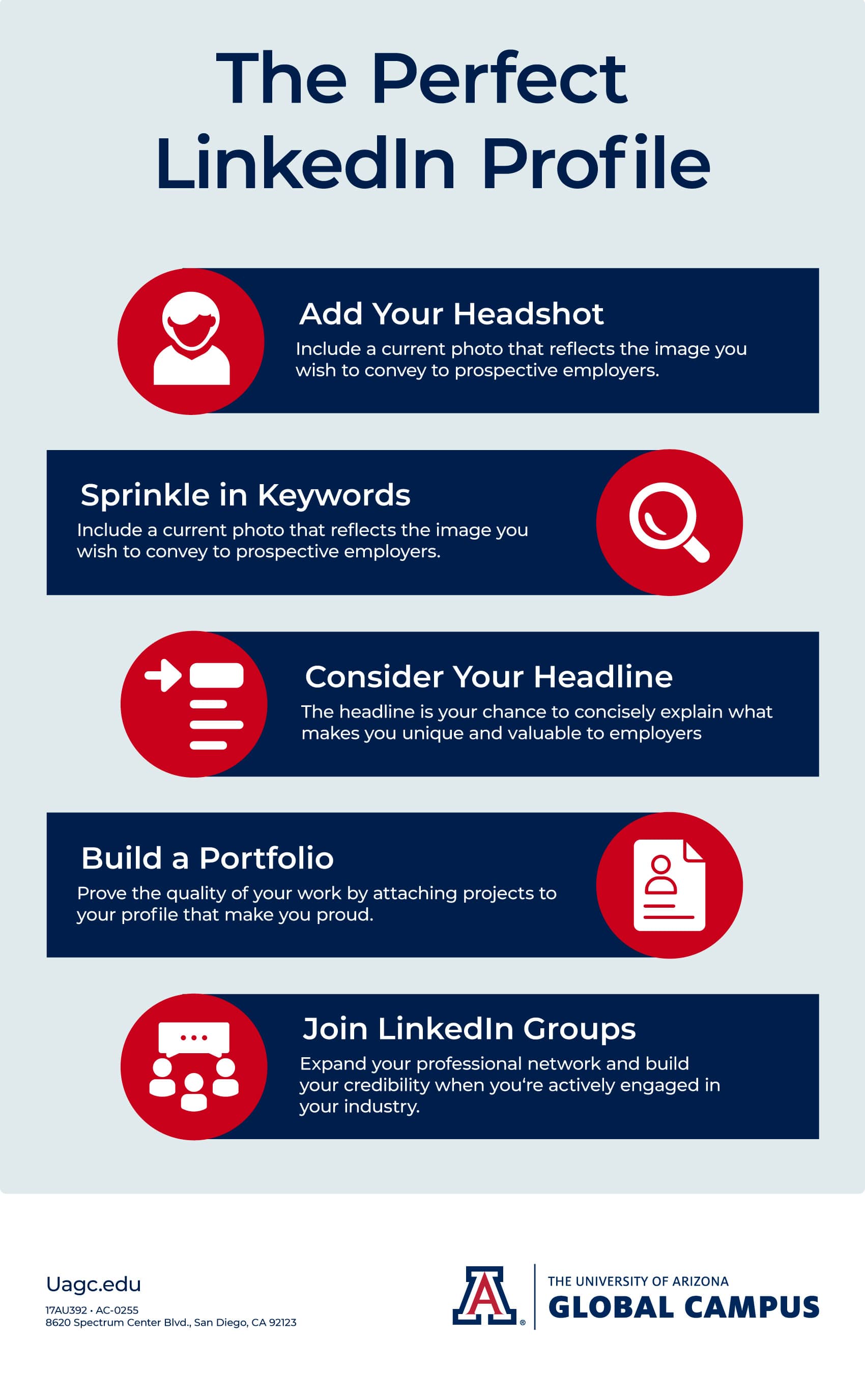View the Infographic »
Used almost exclusively for professional purposes, LinkedIn stands apart from other social media platforms—you’ll find very few cat videos and food photos on LinkedIn profiles. Instead, people tend to use the site as an online resume. Most modern professionals seem to understand the need for a presence on LinkedIn, but they may not always understand how to create an effective profile. There are numerous ways to enrich your profile, but the following five tips are sure to give you a leg up on the competition.
Picture Yourself
To some people, the idea of adding their face to a LinkedIn profile feels narcissistic and wrong. After all, most of us wouldn’t ever think of slapping a picture on our resume. But the practice of including a picture has become the norm on LinkedIn, just as it has on other social media platforms. Profiles without pictures appear incomplete.
You don’t need to pay for professional headshots, but make sure your profile picture presents the image you wish to convey. Dress for the kind of job you want, make sure the photo is clear, avoid pictures with other people in them, and try to pick a photo that is current.
Additionally, the fields at the top of your profile include name, current position, and location. Many LinkedIn users don’t think to do this, but you can use the "current" position field as a sales pitch. State your specialty instead of your job and talk about where you want to go rather than where you are.
They Call Them “Keywords” for a Reason
If you’re hoping that prospective employers will find you on LinkedIn, then keywords are… well… key. The search function on LinkedIn looks for keywords and recruiters will often use that search function to locate potential candidates. Even if you’re not actively looking for a new job, your dream job could find you if you sprinkle the right keywords throughout your profile.
The Google AdWords Keyword Planner is a great resource marketing firms use to research popular keywords, but you can use it to build your profile. The tool allows you to pinpoint the relevant words and phrases that people (including recruiters) are looking for in online searches. Just be sure the keywords you select accurately represent your skills and experience.
Once you’ve nailed down your keywords, incorporate them into your profile. Be sure to include your most significant keywords in your profile’s headline. Then add them to your summary, include them in your work experience, and possibly even drop them into areas such as your education and volunteer activities. In regards to your summary, LinkedIn provides 2,000 characters in your summary to make a great impression. Use every one of them. The summary is your elevator pitch – a quick introduction that will make potential employers want to learn more. Highlight your top accomplishments and skills, but leave the nitty-gritty details for elsewhere in your profile. Pay attention to presentation. Break up sections with bold text or lines that make your summary easier to read.
Speaking of Headlines…
Give some serious thought to your profile’s headline. Many people simply slap their current job title into the headline, but one must realize that the headline is the first thing people will likely see in your profile. You’re more than just a job title, so use that space to sell yourself. Get creative and try to explain what makes you unique or which skills make you valuable to employers. A headline that reads “Relationship Builder, Negotiator and Deal Closer” is far more descriptive and eye-catching than “Sales Manager.”
One other tip to consider regarding profile headlines is to add your email address. Your name and headline will pop up in search engines. If your contact information is in your headline, recruiters will be able to connect with you without logging in to LinkedIn, cutting out the middle man. Additionally, a great way to make your profile more personal and gain the most visibility possible is to customize your public profile URL on LinkedIn. This personalization allows you to claim your name, which will show up in your URL—for instance: https://www.linkedin.com/in/joesmith. LinkedIn has instructions for claiming your custom public profile URL.
Experience: Samples and Examples
Use your job entries to build on the story you started in your summary. Describe milestones and achievements rather than duties. Summarize major projects and highlight successes that set you apart. Use attachments to back up all of the skills and experience you’ve listed on your profile. LinkedIn allows you to add documents, photos, videos, and presentations that can serve as work samples. If you say you’re a wiz at writing press releases, prove it by attaching an example. If you’re especially proud of a major presentation you’ve done, why not include it? Let your hard work speak for itself.
Many creative professionals, such as writers and graphic artists, already have portfolios or blogs stashed away somewhere on the web. If you’ve established a portfolio elsewhere, there’s no need to rebuild it in LinkedIn. Be sure to include links to the portfolio though and possibly include a couple of samples to whet the appetite of anyone who finds your profile.
Additionally, for those starting in the workforce or changing careers, listing volunteer experience is a great way to highlight off-resume skills. Were you in charge of your PTA’s $30,000 fund-raiser? Make sure you list it. Skills you applied outside of a professional setting can also be relevant in your business setting.
Volunteerism creates a networking opportunity of its own. An optimized profile clearly listing your contributions will lead to communication from organizations in your area. Those communication opportunities will give you the chance to continue doing good work while making great connections.
Be a Joiner
If you tend to think of LinkedIn as an online repository for resumes, you may be neglecting the social aspect of the platform. There are two excellent reasons to consider joining some LinkedIn groups. First, you will have an opportunity to expand your network and make new contacts (you never know which contact will want to hire you somewhere down the line).
The second reason to join LinkedIn groups is credibility. Involvement in groups that are specific to your industry conveys the idea that you’re serious about your career and you’re knowledgeable about your industry. You can start your foray into LinkedIn groups by joining the Ashford University Alumni & Students group.
If you happen to work directly with any of these connections, recommendations can also be valuable. Ask your connections, co-workers, and supervisors to post some for you. Offer to write a recommendation in kind. If you have a specific position in mind, ask them to speak to your skills in key requirements in the posting.
Additional LinkedIn Insights for Students
Now that you have a better understanding of how to create a unique LinkedIn profile, there are some additional bits of information that you should know as a student. LinkedIn, has unveiled a new Field of Study Explorer that reveals how other professionals are using their college degrees. If you are unsure about your plans after graduation, this tool can help you discover careers for professionals with your degree. This tool can better help you uncover companies who have hired professionals with your degree, and help you build your network and gain access to new career paths.
LinkedIn is a wonderful opportunity to put your credentials before millions of people. Make sure your profile gives potential employers a complete picture that goes beyond resume bullets. This profile is a powerful supplement to traditional job-seeking tools like resumes and cover letters. Whether you’re looking for a job or not, an up-to-date and robust LinkedIn profile can be a big asset. With the five elements listed above, your profile will make a bold first impression.
--

Written by University Staff
